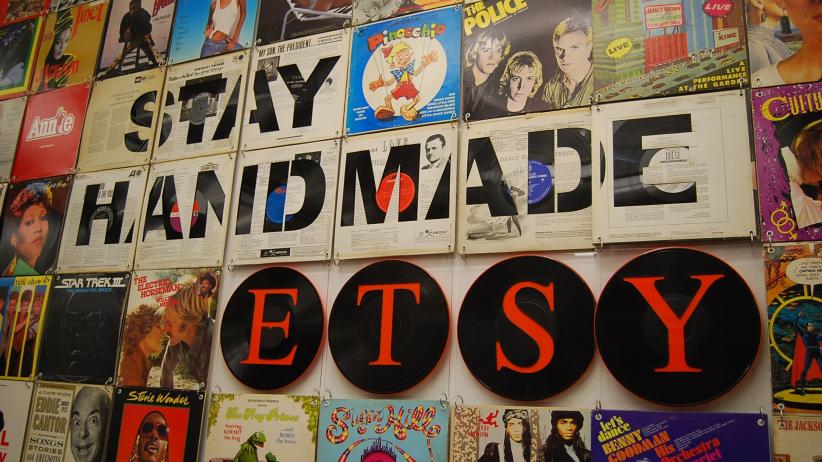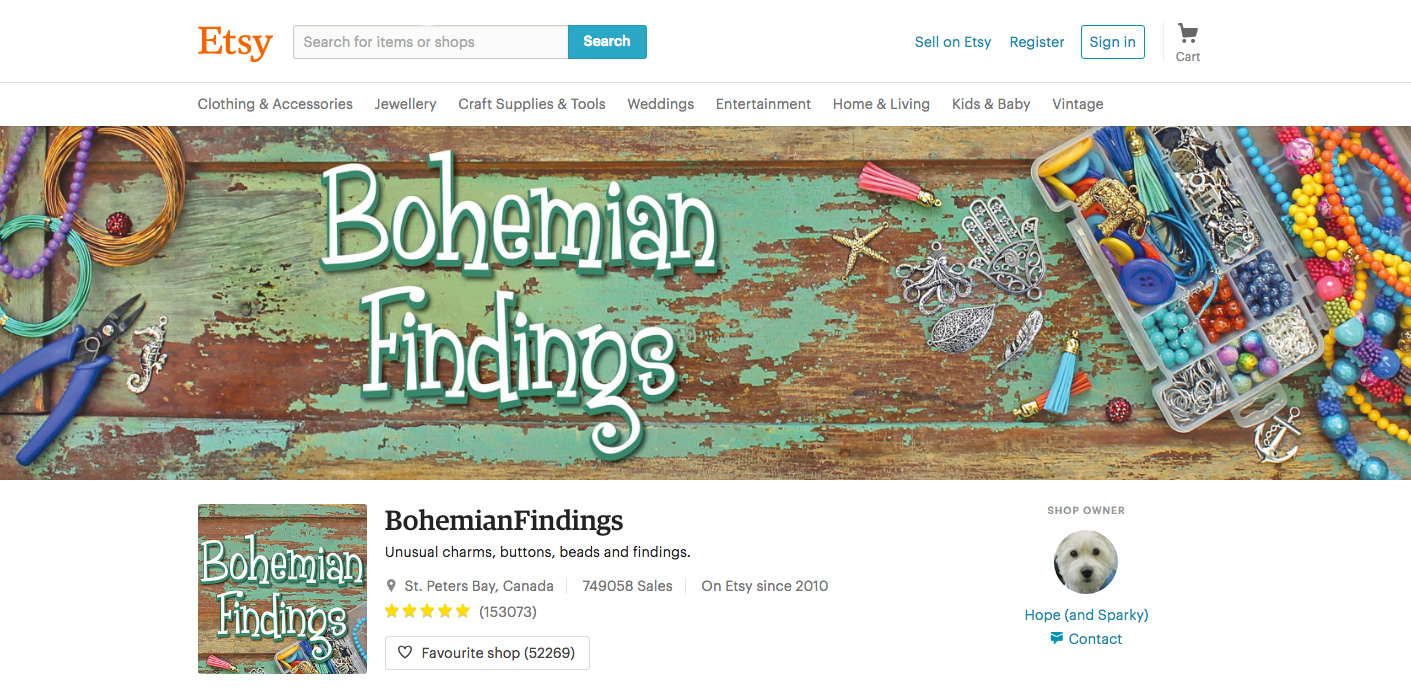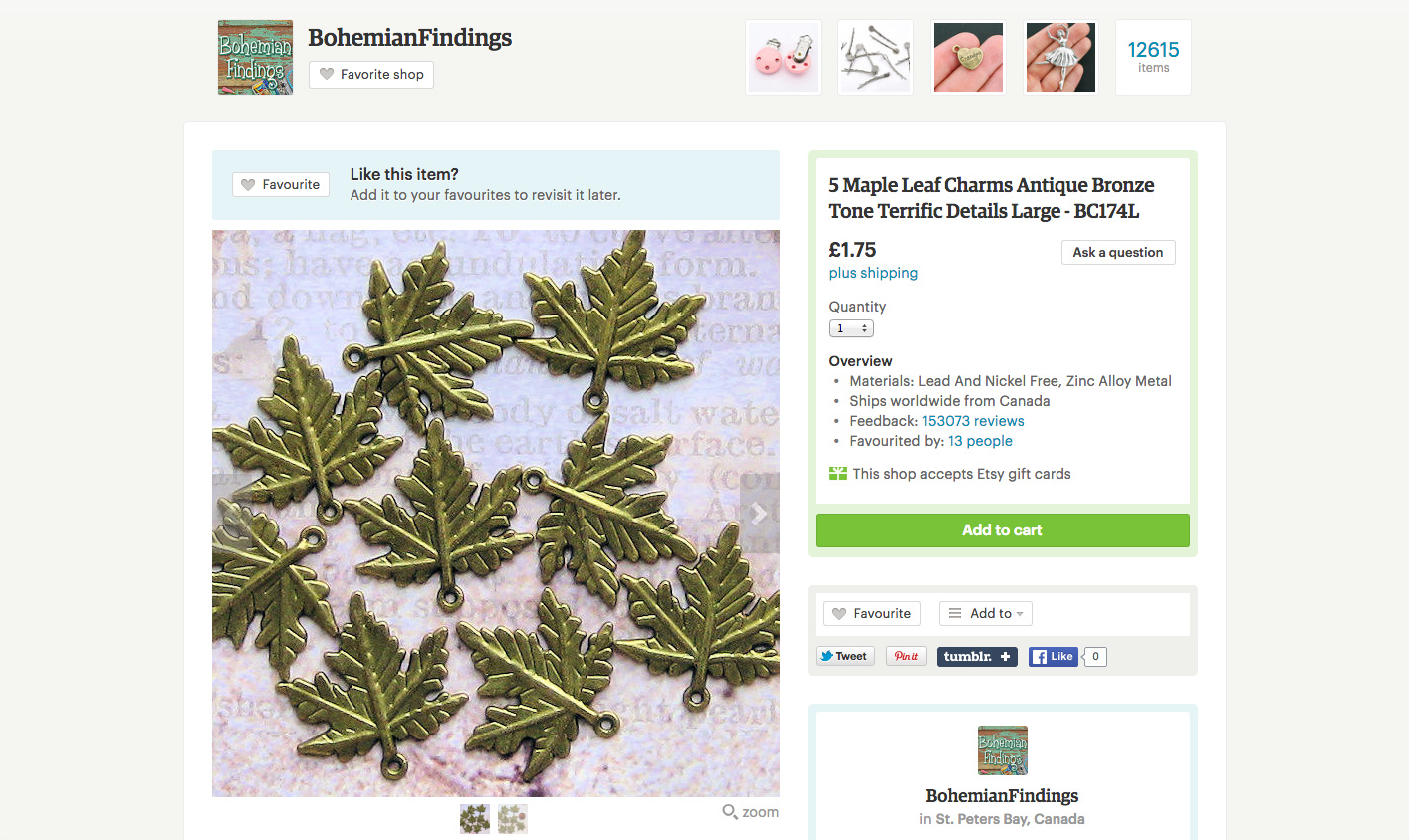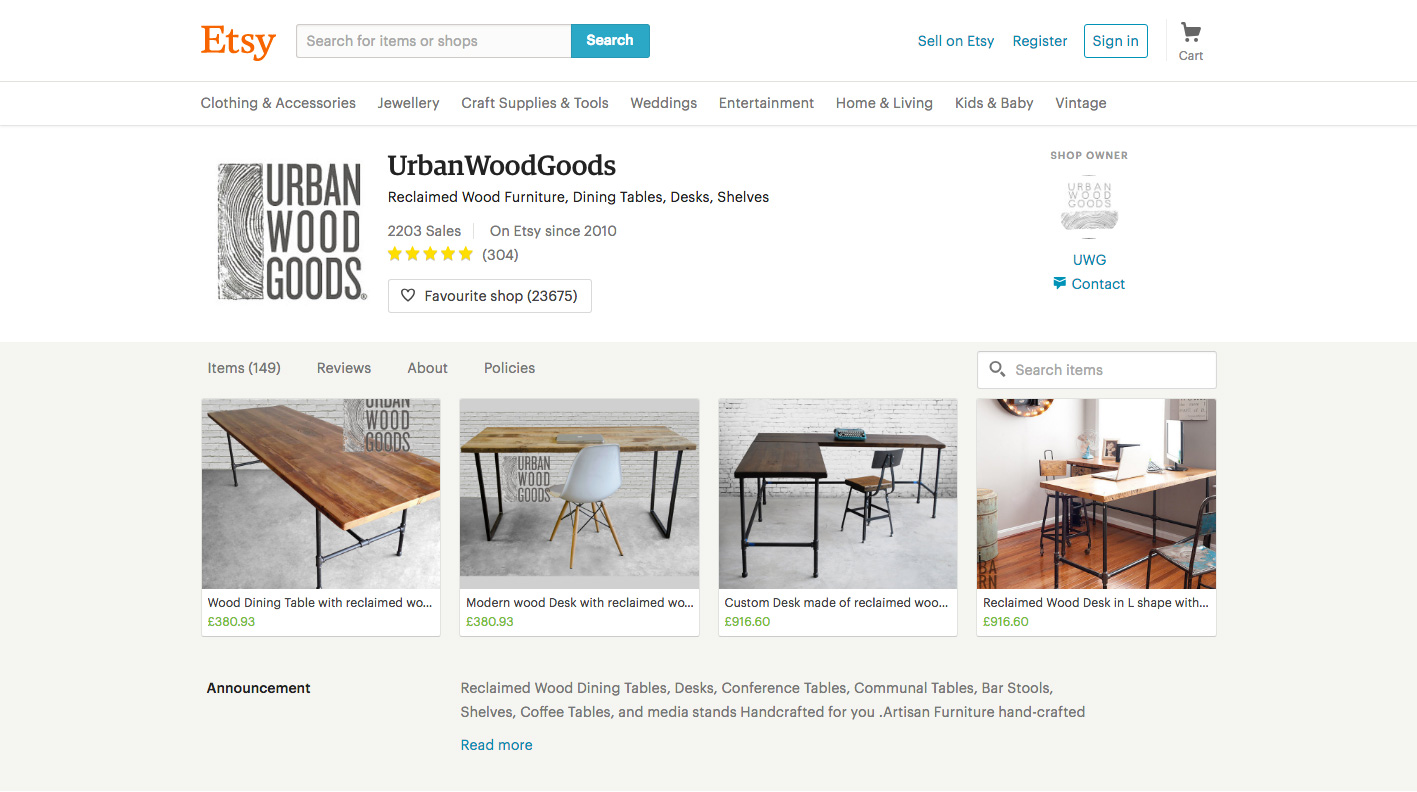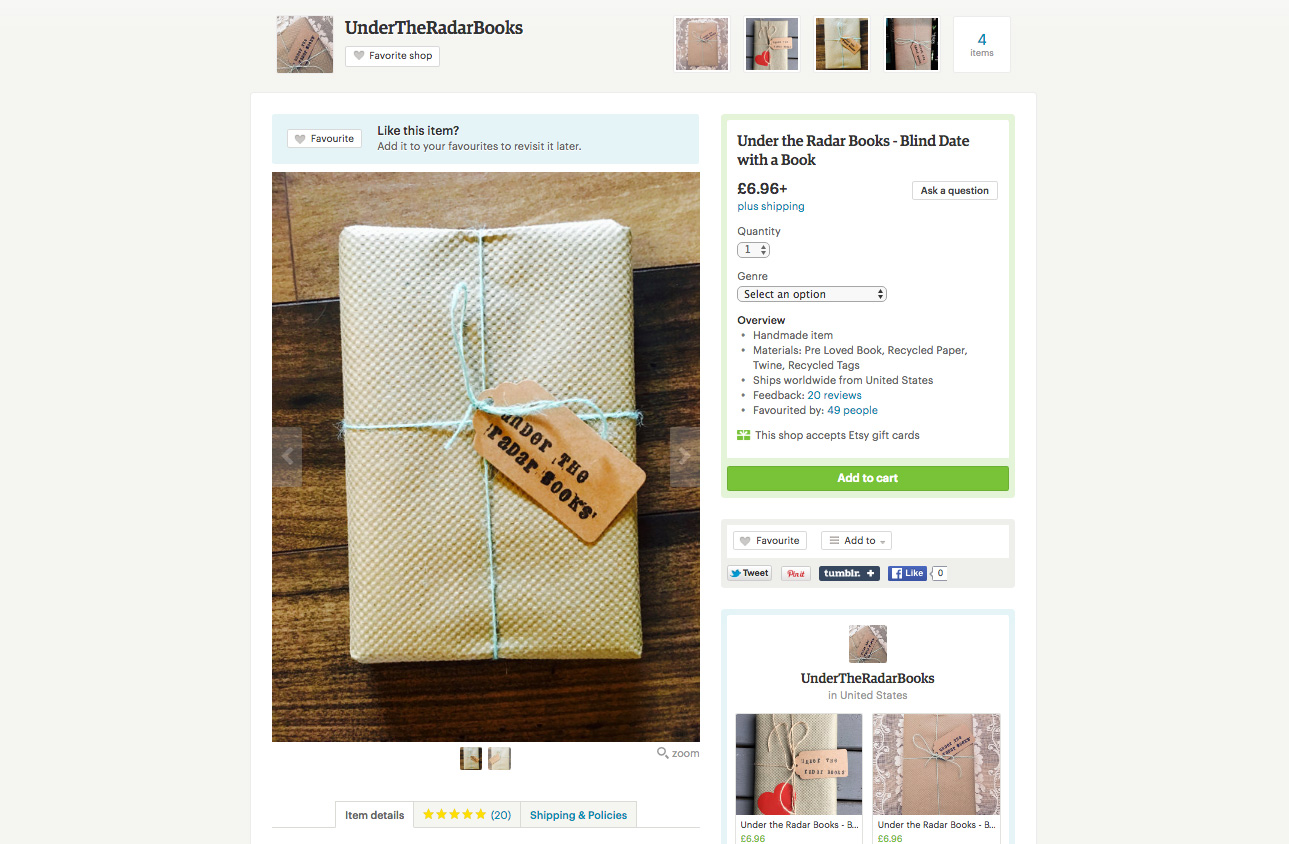Etsy is the visible face of artisanal e-commerce. With 1.6 million stores selling over 35 million products, it’s thriving, and some of its best sellers are easily matching independent e-commerce for sales and revenue. But whether your business relies on Etsy, you use it as a side channel or you’ve never been near the web’s premium collection of crafters, there are lessons to be learned from the best Etsy stores that all etailers can apply. Here’s what you can learn from 10 of the best stores on Etsy:
1. Yadana Beads: Define Your Niche
Etsy is all about niche selling because it’s a crowded marketplace. Trying to be all things to all people won’t fly in a space like that: you have to specialize. It’s about finding something you can be the best at, and then owning that space.
The rest of e-commerce is like that too. It’s not just that there’s little margin in competing to sell everything to everyone, but that there are already successful companies dedicated to doing just that. Maybe you’ll never be Amazon – but you can be the Amazon of your niche.
That’s Yadana Beads: they’ve got beads sewn up. They might sell a couple of other things as well, but they based the identity of their brand around the niche they wanted to corner.
How do you identify the right niche? In Etsy-preneurship: Everything You Need to Know to Turn Your Handmade Hobby Into a Thriving Business, author Jason Malinak observes that a niche ‘needs to be narrow enough that you can influence it, but wide enough that you still have enough customers.’
Catherine Ivins, of Etsy store Polarity, advises: ‘Don’t try to be all things to all people… you don’t have to worry about the millions of people out there who will not like/want/need your craft, you just have to focus on reaching the people who will love you.’
Defining and owning your niche is as vital across e-commerce as it is on Etsy.
The best way to ensure long-term e-commerce success is to research and validate your niche in advance: ‘The single biggest mistake entrepreneurs make when choosing their first e-commerce niche is they don’t do enough research,’ says Shabbir Nooruddin of Bootstrapping E-commerce.
His advice? ‘Validate your niche in advance before diving head first into it.’
So how do you go about doing that?
- Try selling at a farmer’s market or at street fair first – This is probably the best way to see if real people have a taste for what you’re planning on getting into online. If you make a lot of sales at these types of events, you have a good shot of selling online. If you get no sales, you might want to re-think your enterprise.
- Survey! – Depending on where you have the biggest following, try surveying your audience. Either ask them directly what they would buy from you or try presenting a few options. Twitter, Facebook and Instagram are all easy places to post these kinds of questions (you can run a poll on Twitter). If you have a blog or website that already gets traffic, try using a tool like Qualaroo. Remember, the more data you collect, the better conclusion you can make.
- Try selling on Craigslist, Ebay, and even Facebook – These channels may be a faster way to validate before you go set up an entire e-commerce storefront. Facebook now allows you to sell through your Facebook page as well.
2. Bohemian Findings: Pick the Right Name
Bohemian Findings caters to Etsy’s core market niche – charm-sized boho discoveries that feel exclusive, fun and interesting. But the store name doesn’t speak to the physical items on display.
There’s a debate you’re going to need to have here with yourself – do you name the niche you serve in the store name? Or do you go for a broader approach, one that leaves you room to grow and develop as a brand?
Choosing a name that the niche you serve, or the product you sell, does have SEO (Search Engine Optimization) benefits. That means it can be easier for search engines to find you. Your number one search term is in the name of your store so you’re more likely to get found. And that’s just the same across e-commerce – choosing the right store name and domain can set you up with a URL to build a winning SEO strategy on.
But it can also be constricting – you might find your store develops and expands beyond that original remit. Then you’re suffering an SEO backlash as people find you by searching for something you don’t really do anymore.
Bohemian Findings’ name addresses the identity of the brand and the value they deliver to their core clientele, and it’s obviously working for them: with sales of 749,058 they’re among the best-selling store on Etsy.
Looking for the perfect name? Try Domainr or NameStation, both e-commerce store name generators – and here’s a bunch of Etsy store name generators. Take both with a large pinch of salt, but they can be useful for inspiration.
3. Snapcrafty: Build Your Brand
Branding is how you link the satisfaction your products create in your customers, with your company. It’s why we hoover floors and clean things up with Kleenex. Who wouldn’t want some of that?
SnapCrafty’s fun, recognizable imagery sets the store apart and raises expectations of pleasure, professionalism and quality for shoppers.
Trouble is, Etsy is a difficult place to build a brand. As Kleenex got bigger they got more recognizable. But ‘as you get bigger as an Etsy seller, there’s little opportunity for branding,’ says Emily McDowell of Emily McDowell Studio. That’s because ‘people say “I bought this on Etsy,” not “from Emily McDowell’s shop.” Etsy supersedes the brand of the seller.’
Of course, other e-commerce companies are up against something similar. For one thing, all e-commerce brands are swimming with sharks – Amazon, Ebay, Alibaba. If you sell through these online marketplaces, you’re getting the effect McDowell identifies: people will say, ‘I bought it on Amazon.’ If not, you’re still struggling to differentiate your brand and identify yourself to customers who all too often say, ‘yeah, I got it online.’
Strategies to drive better branding include:
Logo design and placement. Get a logo designed professionally and display it everywhere you can, including online assets and offline ones like packaging.
Personalization. The more you can personalize the customer experience you’re offering, the better pleased your customers will be.
Unique Selling Proposition. USPs are how you differentiate yourself in what appears to be a crowded field: show how you don’t really do the same thing as your competitors. Sure, the product or service may be similar – but the results are so different that your brand stands alone. (Think Hoover…)
4. PNT Dolls: Figure Your Price Point
Setting your price point in e-commerce is essential to success. Pricing has to walk a fine line – on the one side, everything you need to pay out, from materials and manufacture through to e-commerce and payment gateway fees (oh, and your profit margin) all has to come out of your products’ prices. On the other hand, you’re competing, people like a bargain and you have to nail a price point your target customers will actually be happy to pay.
PNT dolls take an unusual approach to this on Etsy by averaging the cost of their products across their entire range. That way when you’re shopping at their store, you’re never in doubt: (almost) everything’s $14.
For other Etsy sellers, that’s not the case. There are several different price points represented across the spectrum, with some sellers reporting top selling price ranges and others with two or more best-selling price points.
For instance, in this discussion thread, Lisa and Don from HooknSaw report selling most products in the $42-52 range; Beachwalker Boxes say they don’t sell much over $200; and Katherine Bowen from LilyandPeaBody reports two best sellers, one at $10 and the other at $280.
While that might sound off the wall, the truth is many businesses see similar pricing effects. Etsy sellers get the same solid basic pricing advice as other e-commerce businesses because the requirements are essentially the same. Dive deeper and there’s a huge amount of information on how to price right. Like all business decisions, though your mileage definitely will vary, and in ways that you might not foresee. So the best basis for pricing decisions is the information on your sales you’ll gather as you go.
5. Urban Wood Goods: Sell Items You’re Passionate About
Urban Wood Goods sell reclaimed and reconditioned furniture. The store began as a side project for art teacher Erin True, who pursued arts and crafts projects outside work. When she put her first item on Etsy, she didn’t believe it would sell – when it did, she had to drive from Chicago to Detroit to deliver it herself!
These days Urban Wood Good is a full-size business with employees and a 3,000ft workshop space, built up on top of a $400 loan from True’s then-fiance, now-husband, who runs the business with her.
Working in a space she’s passionate and knowledgeable about let True build a thriving business. If you’re going to make an e-commerce store work it pays to build it on that knowledge and passion.
But then you probably already knew that: Most e-commerce businesses, on or off Etsy, start out like Erin True’s – based on passion
6. Metalicious: Make Your Photographs Irresistible
In a real life store, you can feel things between your fingers, walk around them, look at them against yourself or other items. You can sit on the beds and chairs, heft the fabrics, try on the jewelry. Online, there’s just images and copy.
To replace some of the offline experience, it helps to offer your customers great photos. If you can, it goes without saying, hire a pro. If you can’t, try getting a basic digital camera and tripod and using the same backdrop for everything to give added professionalism for your images and build some branding into them.
Ask yourself which views aren’t offered by the main photo, and where you’d want to look if you were considering buying the item and could pick it up and touch it. Each image is a fresh opportunity to make your store look professional and your product look desirable, but it’s also an opportunity to soothe objections in the customer’s mind: the front looks good, but what if it’s flimsy at the back? What does it look like inside? What’s the texture like up close? Assuage these doubts and you move closer to a sale.
Metalicious does this in style, telling a visual story based on the questions in a customer’s mind. First, two different views of the item.
Note the wooden backdrop emphasizing the brand identity and values – warmth, naturalness, authenticity.
The photos are sharp enough that the texture of the earrings is visible too.
Then, you may be wondering what they’d look like against skin?
How about a clearer view of the product – what does the back look like?
This image is almost diagrammatic – you can see details of the shape of the jewel, the shaft of the stud and the setting.
But what will it look like when it arrives?
Metalicious are killing it in the photography stakes by telling a convincing and compelling story with images that leads you through your questions and objections to end on the package you’ll get through the door. Anticipation, anyone?
7. Paperly People: Learn How SEO Works
SEO was presented to business owners as a mystical art to bring in traffic. That air of the slightly mysterious (and slightly shady) still clings to it.
But in reality SEO – Search Engine Optimization, remember – was never anything more than labeling content so search engines could recognize it. That’s what it still is.
Learning the basics of SEO – including how not to set off the spammy-site alarms over at Google – will pay off in more traffic and more sales.
It’s about matching strategy to the environment, sticking to best practice, and then testing everything. But remember – Google isn’t the only search engine. For a lot of businesses, there’s little point optimizing for Bing, but if your product is an iOS mobile app, the rules to getting found in the App Store are different from standard Google SEO.
For Etsy, the most important places to keyword are Title, Tags and Materials, says Tara Jacobsen; The rules for Google are different but it’s equally important to be findable there. A little time invested in basic SEO will yield dividends – direct search, from people who are looking for a product like yours, is the biggest source of traffic for most e-commerce sites.
8. Waveclock: Use Social Media
Waveclock sells an unusual product with a niche market. That’s perfect for Etsy, and it’s ideal for social media marketing too; in a medium that’s all about community and engagement, having a ‘tribe’ who care about the same stuff you do is really important. Waveclock’s connected clocks tell surfers when the surf is good, linking real-time weather reports to the clock via a smartphone app.
Waveclocks’ social media presence is active and engaged: 888 followers regularly receive updates that are a nice mix of Waveclock-themed material and more general surfing and “beach life” posts.
Issues close to surfers’ hearts, like keeping the beaches and oceans clean, get a name-check.
What’s cool about Waveclocks’ Tweets is that they’re perfect for engaging with surfers – because the Waveclocks team obviously care about this stuff themselves. Their image-heavy Twitter stream shows pics of sunsets, beaches and dolphins, leveraging the power of graphics to increase social media efficacy.
9. Under the Radar Books: Get Creative with Packaging
Under the Radar books caters to another section of the traditional ‘emporium’ market: book fans, looking for the unusual, out-of-print, unexpected. You know; stuff that’s under the radar.
While they serve their customers’ core desire – to buy books they can’t find anywhere else – Under the Radar have taken their packaging to a new level. For e-commerce brands, packaging is super important. It’s where your customers hold your brand in their hands for the first time. It’s a touch point that you should get everything you can out of, creating an unboxing experience, not just a box.
Unboxing experiences turn the process of taking your product out of its box at home into an extension of your brand’s user experience. That creates customer delight, and that delight can drive customers to share their experiences of unboxing your product, generating increased traffic and sales for your brand.
Check out how Under the Radar have turned packaging into a product:
Their ‘blind date with a book’ sets you up with… well, who knows what’s under all that artisanal wrapping? For Under the Radar, the anticipation is clearly a part of the product, and a key facet of the brand experience:
10. Le Papier Studio: Provide Great Customer Service to Encourage Word-Of-Mouth Promotion
The best advert you can have is your customers telling their friends you’re great. Word-of-mouth promotion is the most trusted form of advertising. In an age when ‘a brand is no longer what we tell the consumer it is – it is what consumers tell each other it is,’ as Scott Cook said, the best form of branding you can have is customers who think you’re great.
They’re likely to have friends interested in the same things. So when they talk together, if the need you service comes up, so does your brand. Targeted advertising, right in the moment, and literally made of social proof? That’s the motherlode.
There’s more: customer service is your bottom line. Loyal customers are worth 10X their first purchase, and they’re three times easier to sell to. Customer service might be the single most important thing your business does.
If you wanted to get people raving about how great you are, you’d focus on giving them the one thing they care about more than anything else. And luckily, we know what that is: customer service.
If you give poor customer service you can lose otherwise satisfied customers. If your customer service is great you’ll get referrals.
The key to great customer service is meaningful interaction – listening to and addressing customer concerns. If that sounds a lot like sales and marketing, well, that’s because it is. On Etsy, the heart of communications is through the site’s Conversations channel. Using this, Le Papier Studio owner Vana Chupp addresses customer concerns – including customers who’ve never ordered online before and have concerns about security or delivery – and talks through customer issues. She also gets requests and feedback.
Your business might not do much custom creations, but customer feedback is still important – these are the people you want to delight, so when they tell you what they want, you should be taking notes. And the same customer-focused, highly communicative approach has achieved success for other e-commerce stores too. Customers want to be heard, and they want answers, and they want it pretty much now. As Michiel Gaasterland says:
‘If Customer Service is the New Battleground, then Conversation is where it will be won.’
The way to win it is to extend the conversation across channels and treat it as an opportunity to delight your customers:
Conclusion
The best Etsy stores can teach us how to win on Etsy. But with a couple of minor tweaks, the rules are the same across e-commerce. These guys are killing it on Etsy for the same reasons that the bright lights of e-commerce are winning in their niches. It’s about creating delight at every turn, addressing customer concerns as quickly as possible, making buying effortless, and handcrafting cufflinks from civil war coins. Um, yeah, that’s just Etsy…
About The Author:
Richard Bayston is a freelance blogger and copywriter covering tech, digital marketing and content strategy for SMBs. I’ve also been known to write on health and fitness. Find out more: Richard@RBCopywriting.com or @RBCopywriting. The rest of my time is spent arguing amicably with my wife and Googling the answers.

